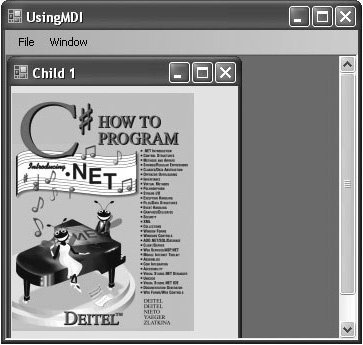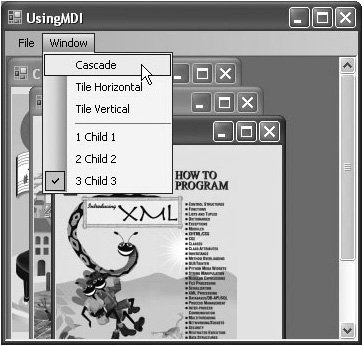Multiple Document Interface (MDI) Windows
In previous chapters, we have built only single document interface (SDI) applications. Such programs (including Microsoft's Notepad and Paint) can support only one open window or document at a time. SDI applications usually have limited abilitiesPaint and Notepad, for example, have limited image- and text-editing features. To edit multiple documents, the user must execute another instance of the SDI application.
Most recent applications are multiple document interface (MDI) programs, which allow users to edit multiple documents at once (e.g. Microsoft Office products). MDI programs also tend to be more complexPaintShop Pro and Photoshop have a greater number of image-editing features than does Paint.
The main application window of an MDI program is called the parent window, and each window inside the application is referred to as a child window. Although an MDI application can have many child windows, each has only one parent window. Furthermore, a maximum of one child window can be active at once. Child windows cannot be parents themselves and cannot be moved outside their parent. Otherwise, a child window behaves like any other window (with regard to closing, minimizing, resizing, etc.). A child window's functionality can be different from the functionality of other child windows of the parent. For example, one child window might allow the user to edit images, another might allow the user to edit text and a third might display network traffic graphically, but all could belong to the same MDI parent. Figure 14.37 depicts a sample MDI application.
Figure 14.37. MDI parent window and MDI child windows.
(This item is displayed on page 696 in the print version)
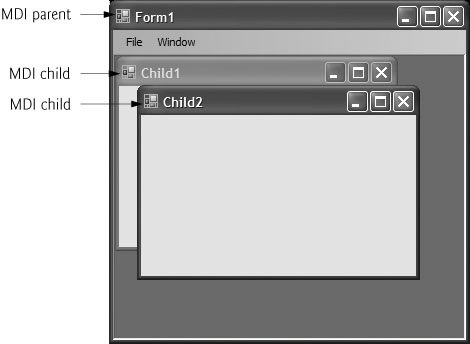
To create an MDI Form, create a new Form and set its IsMdiContainer property to TRue. The Form changes appearance, as in Fig. 14.38.
Figure 14.38. SDI and MDI forms.
(This item is displayed on page 696 in the print version)
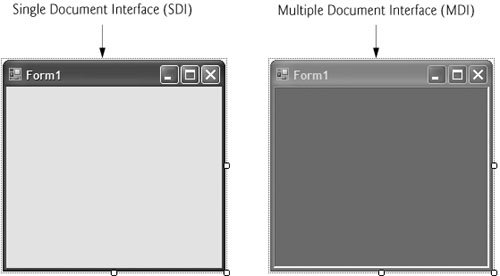
Next, create a child Form class to be added to the Form. To do this, right click the project in the Solution Explorer, select Project > Add Windows Form... and name the file. Edit the Form as you like. To add the child Form to the parent, we must create a new child Form object, set its MdiParent property to the parent Form and call the child Form's Show method. In general, to add a child Form to a parent, write
ChildFormClass childForm = New ChildFormClass(); childForm.MdiParent = parentForm; childForm.Show();
In most cases, the parent Form creates the child, so the parentForm reference is this. The code to create a child usually lies inside an event handler, which creates a new window in response to a user action. Menu selections (such as File, followed by a submenu option of New, followed by a submenu option of Window) are common techniques for creating new child windows.
Class Form property MdiChildren returns an array of child Form references. This is useful if the parent window wants to check the status of all its children (for example, ensuring that all are saved before the parent closes). Property ActiveMdiChild returns a reference to the active child window; it returns Nothing if there are no active child windows. Other features of MDI windows are described in Fig. 14.39.
|
MDI Form properties, a method and an event |
Description |
|---|---|
|
Common MDI Child Properties |
|
|
IsMdiChild |
Indicates whether the Form is an MDI child. If true, Form is an MDI child (read-only property). |
|
MdiParent |
Specifies the MDI parent Form of the child. |
|
Common MDI Parent Properties |
|
|
ActiveMdiChild |
Returns the Form that is the currently active MDI child (returns null if no children are active). |
|
IsMdiContainer |
Indicates whether a Form can be an MDI parent. If TRue, the Form can be an MDI parent. The default value is false. |
|
MdiChildren |
Returns the MDI children as an array of Forms. |
|
Common Method |
|
|
LayoutMdi |
Determines the display of child forms on an MDI parent. The method takes as a parameter an MdiLayout enumeration with possible values ArrangeIcons, Cascade, TileHorizontal and TileVertical. Figure 14.42 depicts the effects of these values. |
|
Common Event |
|
|
MdiChildActivate |
Generated when an MDI child is closed or activated. |
Child windows can be minimized, maximized and closed independently of each other and the parent window. Figure 14.40 shows two images: one containing two minimized child windows and a second containing a maximized child window. When the parent is minimized or closed, the child windows are minimized or closed as well. Notice that the title bar in Fig. 14.40(b) is Form1 - [Child2]. When a child window is maximized, its title bar text is inserted into the parent window's title bar. When a child window is minimized or maximized, its title bar displays a restore icon, which can be used to return the child window to its previous size (its size before it was minimized or maximized).
Figure 14.40. Minimized and maximized child windows.
(This item is displayed on page 698 in the print version)

C# provides a property that helps track which child windows are open in an MDI container. Property MdiWindowListItem of class MenuStrip specifies which menu, if any, displays a list of open child windows. When a new child window is opened, an entry is added to the list (as in the first screen of Figure 14.41). If nine or more child windows are open, the list includes the option More Windows..., which allows the user to select a window from a list in a dialog.
Figure 14.41. MenuItem property MdiList example.
(This item is displayed on page 698 in the print version)
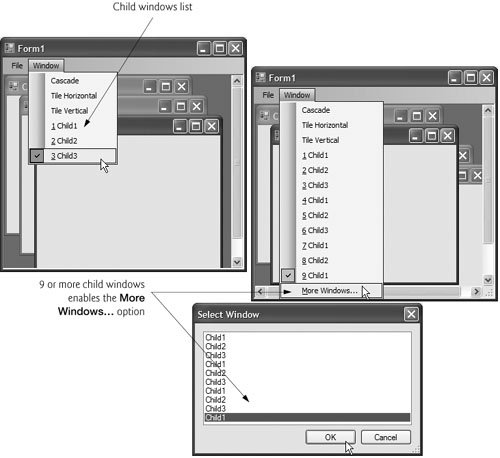
MDI containers allow you to organize the placement ofs child windows. The child windows in an MDI application can be arranged by calling method LayoutMdi of the parent Form. Method LayoutMdi takes a MdiLayout enumeration, which can have values ArrangeIcons, Cascade, TileHorizontal and TileVertical. Tiled windows completely fill the parent and do not overlap; such windows can be arranged horizontally (value TileHorizontal) or vertically (value TileVertical). Cascaded windows (value Cascade) overlapeach is the same size and displays a visible title bar, if possible. Value ArrangeIcons arranges the icons for any minimized child windows. If minimized windows are scattered around the parent window, value ArrangeIcons orders them neatly at the bottom-left corner of the parent window. Figure 14.42 illustrates the values of the MdiLayout enumeration.
Figure 14.42. MdiLayout enumeration values.
(a) ArrangeIcons
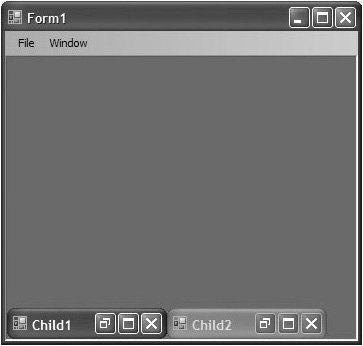
(b) Cascade
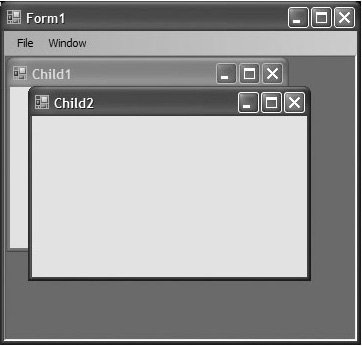
(c) TileHorizontal

(d) TileVertical
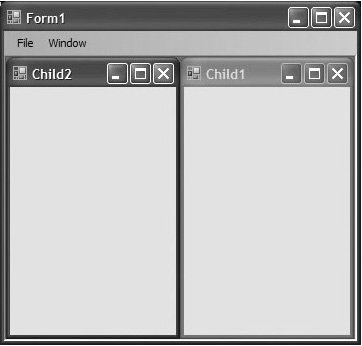
Class UsingMDIForm (Fig. 14.43) demonstrates MDI windows. Class UsingMDIForm uses three instances of child Form ChildForm (Fig. 14.44), each containing a PictureBox that displays an image. The parent MDI Form contains a menu enabling users to create and arrange child Forms.
Figure 14.43. MDI parent-window class.
1 // Fig. 14.43: UsingMDIForm.cs
2 // Demonstrating use of MDI parent and child windows.
3 using System;
4 using System.Windows.Forms;
5
6 // Form demonstrates the use of MDI parent and child windows
7 public partial class UsingMDIForm : Form
8 {
9 // default constructor
10 public UsingMDIForm()
11 {
12 InitializeComponent();
13 } // end constructor
14
15 // create Child 1 window when child1ToolStrip MenuItem is clicked
16 private void child1ToolStripMenuItem_Click(
17 object sender, EventArgs e )
18 {
19 // create new child
20 ChildForm formChild =
21 new ChildForm( "Child 1", @"imagescsharphtp1.jpg" );
22 formChild.MdiParent = this; // set parent
23 formChild.Show(); // display child
24 } // end method child1ToolStripMenuItem_Click
25
26 // create Child 2 window when child2ToolStripMenuItem is clicked
27 private void child2ToolStripMenuItem_Click(
28 object sender, EventArgs e )
29 {
30 // create new child
31 ChildForm formChild =
32 new ChildForm( "Child 2", @"imagesvbnethtp2.jpg" );
33 formChild.MdiParent = this; // set parent
34 formChild.Show(); // display child
35 } // end method child2ToolStripMenuItem_Click
36
37 // create Child 3 window when child3ToolStripMenuItem is clicked
38 private void child3ToolStripMenuItem_Click(
39 object sender, EventArgs e )
40 {
41 // create new child 42 Child formChild = 43 new Child( "Child 3", @"imagespythonhtp1.jpg" ); 44 formChild.MdiParent = this; // set parent 45 formChild.Show(); // display child 46 } // end method child3ToolStripMenuItem_Click 47 48 // exit application 49 private void exitToolStripMenuItem_Click( object sender, EventArgs e ) 50 { 51 Application.Exit(); 52 } // end method exitToolStripMenuItem_Click 53 54 // set Cascade layout 55 private void cascadeToolStripMenuItem_Click( 56 object sender, EventArgs e ) 57 { 58 this.LayoutMdi( MdiLayout.Cascade ); 59 } // end method cascadeToolStripMenuItem_Click 60 61 // set TileHorizontal layout 62 private void tileHorizontalToolStripMenuItem_Click( 63 object sender, EventArgs e ) 64 { 65 this.LayoutMdi( MdiLayout.TileHorizontal ); 66 } // end method tileHorizontalToolStripMenuItem 67 68 // set TileVertical layout 69 private void tileVerticalToolStripMenuItem_Click( 70 object sender, EventArgs e ) 71 { 72 this.LayoutMdi( MdiLayout.TileVertical ); 73 } // end method tileVerticalToolStripMenuItem_Click 74 } // end class UsingMDIForm
(a)
(b)
(c)
(d)
|
Figure 14.44. MDI child ChildForm.
(This item is displayed on pages 702 - 703 in the print version)
1 // Fig. 14.44: ChildForm.cs 2 // Child window of MDI parent. 3 using System; 4 using System.Drawing; 5 using System.Windows.Forms; 6 using System.IO; 78 public partial class ChildForm : Form 9 { 10 public ChildForm( string title, string fileName ) 11 { 12 // Required for Windows Form Designer support 13 InitializeComponent(); 14 15 Text = title; // set title text 16 17 // set image to display in pictureBox 18 picDisplay.Image = Image.FromFile( 19 Directory.GetCurrentDirectory() + fileName ); 20 } // end constructor 21 } // end class ChildForm |
The program in Fig. 14.43 is the application. The MDI parent Form, which is created first, contains two top-level menus. The first of these menus, File (fileToolStripMenuItem), contains both an Exit item (exitToolStripMenuItem) and a New submenu (newToolStripMenuItem) consisting of items for each child window. The second menu, Window (windowToolStripMenuItem), provides options for laying out the MDI children, plus a list of the active MDI children.
In the Properties window, we set the Form's IsMdiContainer property to true, making the Form an MDI parent. In addition, we set the MenuStrip's MdiWindowListItem property to windowToolStripMenuItem. This enables the Window menu to contain the list of child MDI windows.
The Cascade menu item (cascadeToolStripMenuItem) has an event handler (cascadeToolStripMenuItem_Click, lines 5559) that arranges the child windows in a cascading manner. The event handler calls method LayoutMdi with the argument Cascade from the MdiLayout enumeration (line 58).
The Tile Horizontal menu item (tileHorizontalToolStripMenuItem) has an event handler (tileHorizontalToolStripMenuItem_Click, lines 6266) that arranges the child windows in a horizontal manner. The event handler calls method LayoutMdi with the argument TileHorizontal from the MdiLayout enumeration (line 65).
Finally, the Tile Vertical menu item (tileVerticalToolStripMenuItem) has an event handler (tileVerticalToolStripMenuItem_Click, lines 6973) that arranges the child windows in a vertical manner. The event handler calls method LayoutMdi with the argument TileVertical from the MdiLayout enumeration (line 72).
At this point, the application is still incompletewe must define the MDI child class. To do this, right click the project in the Solution Explorer and select Add > Windows Form.... Then name the new class in the dialog as ChildForm (Fig. 14.44). Next, we add a PictureBox (picDisplay) to ChildForm. In the constructor, line 15 sets the title bar text. Lines 1819 set ChildForm's Image property to an Image, using method FromFile.
After the MDI child class is defined, the parent MDI Form (Fig. 14.43) can create new child windows. The event handlers in lines 1646 create a new child Form corresponding to the menu item clicked. Lines 2021, 3132 and 4243 create new instances of ChildForm. Lines 22, 33 and 44 set each Child's MdiParent property to the parent Form. Lines 23, 34 and 45 call method Show to display each child Form.
Preface
Index
Introduction to Computers, the Internet and Visual C#
- Introduction
- What Is a Computer?
- Computer Organization
- Early Operating Systems
- Personal Computing, Distributed Computing and Client/Server Computing
- Hardware Trends
- Microsofts Windows® Operating System
- Machine Languages, Assembly Languages and High-Level Languages
- C#
- C, C++, Java and Visual Basic
- Other High-Level Languages
- The Internet and the World Wide Web
- Extensible Markup Language (XML)
- Microsofts .NET
- The .NET Framework and the Common Language Runtime
- Test-Driving a C# Application
- Software Engineering Case Study: Introduction to Object Technology and the UML
- Wrap-Up
- Web Resources
- Summary
- Terminology
- Self-Review Exercises
- Exercises
Introduction to the Visual C# 2005 Express Edition IDE
- Introduction
- Overview of the Visual Studio 2005 IDE
- Menu Bar and Toolbar
- Navigating the Visual Studio 2005 IDE
- Using Help
- Using Visual Programming to Create a Simple Program Displaying Text and an Image
- Wrap-Up
- Web Resources
- Summary
- Terminology
- Self-Review Exercises
- Exercises
Introduction to C# Applications
- Introduction
- A Simple C# Application: Displaying a Line of Text
- Creating Your Simple Application in Visual C# Express
- Modifying Your Simple C# Application
- Formatting Text with Console.Write and Console.WriteLine
- Another C# Application: Adding Integers
- Memory Concepts
- Arithmetic
- Decision Making: Equality and Relational Operators
- (Optional) Software Engineering Case Study: Examining the ATM Requirements Document
- Wrap-Up
- Summary
- Terminology
- Self-Review Exercises
- Exercises
Introduction to Classes and Objects
- Introduction
- Classes, Objects, Methods, Properties and Instance Variables
- Declaring a Class with a Method and Instantiating an Object of a Class
- Declaring a Method with a Parameter
- Instance Variables and Properties
- UML Class Diagram with a Property
- Software Engineering with Properties and set and get Accessors
- Value Types vs. Reference Types
- Initializing Objects with Constructors
- Floating-Point Numbers and Type decimal
- (Optional) Software Engineering Case Study: Identifying the Classes in the ATM Requirements Document
- Wrap-Up
- Summary
- Terminology
- Self-Review Exercises
- Exercises
Control Statements: Part 1
- Introduction
- Algorithms
- Pseudocode
- Control Structures
- if Single-Selection Statement
- if...else Double-Selection Statement
- while Repetition Statement
- Formulating Algorithms: Counter-Controlled Repetition
- Formulating Algorithms: Sentinel-Controlled Repetition
- Formulating Algorithms: Nested Control Statements
- Compound Assignment Operators
- Increment and Decrement Operators
- Simple Types
- (Optional) Software Engineering Case Study: Identifying Class Attributes in the ATM System
- Wrap-Up
- Summary
- Terminology
- Self-Review Exercises
- Exercises
Control Statements: Part 2
- Introduction
- Essentials of Counter-Controlled Repetition
- for Repetition Statement
- Examples Using the for Statement
- do...while Repetition Statement
- switch Multiple-Selection Statement
- break and continue Statements
- Logical Operators
- Structured Programming Summary
- (Optional) Software Engineering Case Study: Identifying Objects States and Activities in the ATM System
- Wrap-Up
- Summary
- Terminology
- Self-Review Exercises
- Exercises
Methods: A Deeper Look
- Introduction
- Packaging Code in C#
- static Methods, static Variables and Class Math
- Declaring Methods with Multiple Parameters
- Notes on Declaring and Using Methods
- Method Call Stack and Activation Records
- Argument Promotion and Casting
- The Framework Class Library
- Case Study: Random-Number Generation
- Case Study: A Game of Chance (Introducing Enumerations)
- Scope of Declarations
- Method Overloading
- Recursion
- Passing Arguments: Pass-by-Value vs. Pass-by-Reference
- (Optional) Software Engineering Case Study: Identifying Class Operations in the ATM System
- Wrap-Up
- Summary
- Terminology
- Self-Review Exercises
- Exercises
Arrays
- Introduction
- Arrays
- Declaring and Creating Arrays
- Examples Using Arrays
- Case Study: Card Shuffling and Dealing Simulation
- foreach Statement
- Passing Arrays and Array Elements to Methods
- Passing Arrays by Value and by Reference
- Case Study: Class GradeBook Using an Array to Store Grades
- Multidimensional Arrays
- Case Study: Class GradeBook Using a Rectangular Array
- Variable-Length Argument Lists
- Using Command-Line Arguments
- (Optional) Software Engineering Case Study: Collaboration Among Objects in the ATM System
- Wrap-Up
- Summary
- Terminology
- Self-Review Exercises
- Exercises
- Special Section: Building Your Own Computer
Classes and Objects: A Deeper Look
- Introduction
- Time Class Case Study
- Controlling Access to Members
- Referring to the Current Objects Members with the this Reference
- Indexers
- Time Class Case Study: Overloaded Constructors
- Default and Parameterless Constructors
- Composition
- Garbage Collection and Destructors
- static Class Members
- readonly Instance Variables
- Software Reusability
- Data Abstraction and Encapsulation
- Time Class Case Study: Creating Class Libraries
- internal Access
- Class View and Object Browser
- (Optional) Software Engineering Case Study: Starting to Program the Classes of the ATM System
- Wrap-Up
- Summary
- Terminology
- Self-Review Exercises
- Exercises
Object-Oriented Programming: Inheritance
- Introduction
- Base Classes and Derived Classes
- protected Members
- Relationship between Base Classes and Derived Classes
- Constructors in Derived Classes
- Software Engineering with Inheritance
- Class object
- Wrap-Up
- Summary
- Terminology
- Self-Review Exercises
- Exercises
Polymorphism, Interfaces & Operator Overloading
- Introduction
- Polymorphism Examples
- Demonstrating Polymorphic Behavior
- Abstract Classes and Methods
- Case Study: Payroll System Using Polymorphism
- sealed Methods and Classes
- Case Study: Creating and Using Interfaces
- Operator Overloading
- (Optional) Software Engineering Case Study: Incorporating Inheritance and Polymorphism into the ATM System
- Wrap-Up
- Summary
- Terminology
- Self-Review Exercises
- Exercises
Exception Handling
- Introduction
- Exception Handling Overview
- Example: Divide by Zero Without Exception Handling
- Example: Handling DivideByZeroExceptions and FormatExceptions
- .NET Exception Hierarchy
- finally Block
- Exception Properties
- User-Defined Exception Classes
- Wrap-Up
- Summary
- Terminology
- Self-Review Exercises
- Exercises
Graphical User Interface Concepts: Part 1
- Introduction
- Windows Forms
- Event Handling
- Control Properties and Layout
- Labels, TextBoxes and Buttons
- GroupBoxes and Panels
- CheckBoxes and RadioButtons
- PictureBoxes
- ToolTips
- NumericUpDown Control
- Mouse-Event Handling
- Keyboard-Event Handling
- Wrap-Up
- Summary
- Terminology
- Self-Review Exercises
- Answers To Self-Review Exercises
- Exercises
Graphical User Interface Concepts: Part 2
- Introduction
- Menus
- MonthCalendar Control
- DateTimePicker Control
- LinkLabel Control
- ListBox Control
- CheckedListBox Control
- ComboBox Control
- TreeView Control
- ListView Control
- TabControl Control
- Multiple Document Interface (MDI) Windows
- Visual Inheritance
- User-Defined Controls
- Wrap-Up
- Summary
- Terminology
- Self-Review Exercises
- Exercises
Multithreading
- Introduction
- Thread States: Life Cycle of a Thread
- Thread Priorities and Thread Scheduling
- Creating and Executing Threads
- Thread Synchronization and Class Monitor
- Producer/Consumer Relationship without Thread Synchronization
- Producer/Consumer Relationship with Thread Synchronization
- Producer/Consumer Relationship: Circular Buffer
- Multithreading with GUIs
- Wrap-Up
- Summary
- Terminology
- Self-Review Exercises
- Exercises
Strings, Characters and Regular Expressions
- Introduction
- Fundamentals of Characters and Strings
- string Constructors
- string Indexer, Length Property and CopyTo Method
- Comparing strings
- Locating Characters and Substrings in strings
- Extracting Substrings from strings
- Concatenating strings
- Miscellaneous string Methods
- Class StringBuilder
- Length and Capacity Properties, EnsureCapacity Method and Indexer of Class StringBuilder
- Append and AppendFormat Methods of Class StringBuilder
- Insert, Remove and Replace Methods of Class StringBuilder
- Char Methods
- Card Shuffling and Dealing Simulation
- Regular Expressions and Class Regex
- Wrap-Up
- Summary
- Terminology
- Self-Review Exercises
- Exercises
Graphics and Multimedia
- Introduction
- Drawing Classes and the Coordinate System
- Graphics Contexts and Graphics Objects
- Color Control
- Font Control
- Drawing Lines, Rectangles and Ovals
- Drawing Arcs
- Drawing Polygons and Polylines
- Advanced Graphics Capabilities
- Introduction to Multimedia
- Loading, Displaying and Scaling Images
- Animating a Series of Images
- Windows Media Player
- Microsoft Agent
- Wrap-Up
- Summary
- Terminology
- Self-Review Exercises
- Exercises
Files and Streams
- Introduction
- Data Hierarchy
- Files and Streams
- Classes File and Directory
- Creating a Sequential-Access Text File
- Reading Data from a Sequential-Access Text File
- Serialization
- Creating a Sequential-Access File Using Object Serialization
- Reading and Deserializing Data from a Sequential-Access Text File
- Wrap-Up
- Summary
- Terminology
- Self-Review Exercises
- Exercises
Extensible Markup Language (XML)
- Introduction
- XML Basics
- Structuring Data
- XML Namespaces
- Document Type Definitions (DTDs)
- W3C XML Schema Documents
- (Optional) Extensible Stylesheet Language and XSL Transformations
- (Optional) Document Object Model (DOM)
- (Optional) Schema Validation with Class XmlReader
- (Optional) XSLT with Class XslCompiledTransform
- Wrap-Up
- Web Resources
- Summary
- Terminology
- Self-Review Exercises
- Exercises
Database, SQL and ADO.NET
- Introduction
- Relational Databases
- Relational Database Overview: Books Database
- SQL
- ADO.NET Object Model
- Programming with ADO.NET: Extracting Information from a Database
- Querying the Books Database
- Programming with ADO.NET: Address Book Case Study
- Using a DataSet to Read and Write XML
- Wrap-Up
- Web Resources
- Summary
- Terminology
- Self-Review Exercises
- Exercises
ASP.NET 2.0, Web Forms and Web Controls
- Introduction
- Simple HTTP Transactions
- Multitier Application Architecture
- Creating and Running a Simple Web-Form Example
- Web Controls
- Session Tracking
- Case Study: Connecting to a Database in ASP.NET
- Case Study: Secure Books Database Application
- Wrap-Up
- Web Resources
- Summary
- Terminology
- Self-Review Exercises
- Exercises
Web Services
- Introduction
- .NET Web Services Basics
- Simple Object Access Protocol (SOAP)
- Publishing and Consuming Web Services
- Session Tracking in Web Services
- Using Web Forms and Web Services
- User-Defined Types in Web Services
- Wrap-Up
- Web Resources
- Summary
- Terminology
- Self-Review Exercises
- Exercises
Networking: Streams-Based Sockets and Datagrams
- Introduction
- Connection-Oriented vs. Connectionless Communication
- Protocols for Transporting Data
- Establishing a Simple TCP Server (Using Stream Sockets)
- Establishing a Simple TCP Client (Using Stream Sockets)
- Client/Server Interaction with Stream-Socket Connections
- Connectionless Client/Server Interaction with Datagrams
- Client/Server Tic-Tac-Toe Using a Multithreaded Server
- WebBrowser Control
- .NET Remoting
- Wrap-Up
- Summary
- Terminology
- Self-Review Exercises
- Exercises
Searching and Sorting
- Introduction
- Searching Algorithms
- Sorting Algorithms
- Wrap-Up
- Summary
- Terminology
- Self-Review Exercises
- Exercises
Data Structures
- Introduction
- Simple-Type structs, Boxing and Unboxing
- Self-Referential Classes
- Linked Lists
- Stacks
- Queues
- Trees
- Wrap-Up
- Summary
- Terminology
- Self-Review Exercises
- Exercises
Generics
- Introduction
- Motivation for Generic Methods
- Generic Method Implementation
- Type Constraints
- Overloading Generic Methods
- Generic Classes
- Notes on Generics and Inheritance
- Wrap-Up
- Summary
- Terminology
- Self-Review Exercises
- Exercises
Collections
- Introduction
- Collections Overview
- Class Array and Enumerators
- Non-Generic Collections
- Generic Collections
- Synchronized Collections
- Wrap-Up
- Summary
- Terminology
- Self-Review Exercises
- Exercises
Appendix A. Operator Precedence Chart
Appendix B. Number Systems
- B.1. Introduction
- B.2. Abbreviating Binary Numbers as Octal and Hexadecimal Numbers
- B.3. Converting Octal and Hexadecimal Numbers to Binary Numbers
- B.4. Converting from Binary, Octal or Hexadecimal to Decimal
- B.5. Converting from Decimal to Binary, Octal or Hexadecimal
- B.6. Negative Binary Numbers: Twos Complement Notation
- Summary
- Terminology
- Self-Review Exercises
- Exercises
Appendix C. Using the Visual Studio 2005 Debugger
- C.1. Introduction
- C.2. Breakpoints and the Continue Command
- C.3. The Locals and Watch Windows
- C.4. Controlling Execution Using the Step Into, Step Over, Step Out and Continue Commands
- C.5. Other Features
- C.6. Wrap-Up
- Summary
- Terminology
- Self-Review Exercises
Appendix D. ASCII Character Set
Appendix E. Unicode®
- E.1. Introduction
- E.2. Unicode Transformation Formats
- E.3. Characters and Glyphs
- E.4. Advantages/Disadvantages of Unicode
- E.5. Using Unicode
- E.6. Character Ranges
- Summary
- Terminology
- Self-Review Exercises
- Answers to Self-Review exercises
- Exercises
Appendix F. Introduction to XHTML: Part 1
- F.1. Introduction
- F.2. Editing XHTML
- F.3. First XHTML Example
- F.4. W3C XHTML Validation Service
- F.5. Headers
- F.6. Linking
- F.7. Images
- F.8. Special Characters and More Line Breaks
- F.9. Unordered Lists
- F.10. Nested and Ordered Lists
- F.11. Web Resources
Appendix G. Introduction to XHTML: Part 2
- G.1. Introduction
- G.2. Basic XHTML Tables
- G.3. Intermediate XHTML Tables and Formatting
- G.4. Basic XHTML Forms
- G.5. More Complex XHTML Forms
- G.6. Internal Linking
- G.7. Creating and Using Image Maps
- G.8. meta Elements
- G.9. frameset Element
- G.10. Nested framesets
- G.11. Web Resources
Appendix H. HTML/XHTML Special Characters
Appendix I. HTML/XHTML Colors
Appendix J. ATM Case Study Code
- Appendix J. ATM Case Study Code
- J.1. ATM Case Study Implementation
- J.2. Class ATM
- J.3. Class Screen
- J.4. Class Keypad
- J.5. Class CashDispenser
- J.6. Class DepositSlot
- J.7. Class Account
- J.8. Class BankDatabase
- J.9. Class Transaction
- J.10. Class BalanceInquiry
- J.11. Class Withdrawal
- J.12. Class Deposit
- J.13. Class ATMCaseStudy
- J.14. Wrap-Up
Appendix K. UML 2: Additional Diagram Types
Appendix L. Simple Types
Index
EAN: 2147483647
Pages: 600


